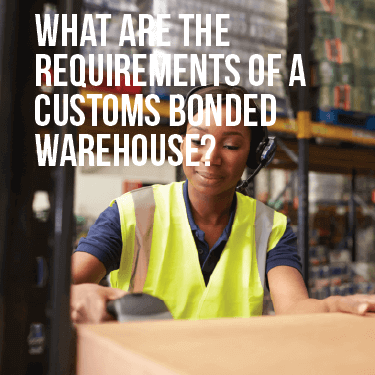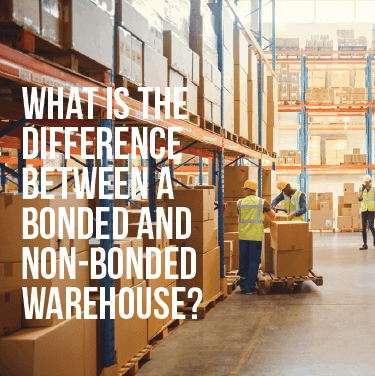
 Copy URL to Clipboard
Copy URL to Clipboard
A bonded warehouse might sound too good to be true. You’ve been struggling to get import duties paid on merchandise that isn’t selling and now you find out there is a way to avoid that. See how taking advantage of a bonded warehouse can save you money and maybe save your business.
U.S. Customs and Border Protection (CBP) regulates the operation of bonded warehouses. Imported goods are stored in these facilities until taxes have been paid. Goods may remain in a bonded warehouse for five years. While the goods can’t be sold, they can undergo manufacturing changes. Duty is paid when the goods are withdrawn.
Learn the basics of bonded warehouses, the benefits of using them, what the requirements are, and more.
Table of Contents
As mentioned, a bonded warehouse is a storage area for imported goods that duty tax must be paid on. Although the term warehouse is used, it can be any secure space, building, or otherwise. Bonded warehousing was developed to help shippers better manage their merchandise and allow them time to prepare goods for distribution.
You can keep your goods in a bonded warehouse for up to five years without paying the duty fees. During this time, you can make any necessary changes to get your imports ready for distribution. This could mean changing packaging, adding necessary labels, or even just waiting until demand has increased.
Bonded warehouses are found in countries all around the world, but they are not subject to any sort of international regulation. While the general purpose is similar, each nation will have unique regulations in place that should be investigated before you decide to use a bonded warehouse outside of U.S. authority.
Bonded warehouses are regulated by the U.S. Customs and Border Protection Agency, commonly known as the CBP. This is why bonded warehouses are sometimes referred to as customs warehouses or even customs bonded warehouses.
Thousands of different goods are imported annually, from vehicle parts to tropical fruits. Such a wide variety of products requires an equally varied availability of suitable warehouses.
Depending on your needs, there are 11 different classes of bonded warehouses in the United States as defined by the CBP.
These classes are specific to the U.S. and may not apply to other countries. If you are considering using a bonded warehouse, consult an expert with knowledge about the variety of options and differences found internationally.
While goods are kept within a bonded warehouse, the importer doesn’t have to pay the import taxes. In that sense, yes, bonded warehouses are duty-free.
However, bonded warehouses are not set up for retail distribution. The duties owed for the imports have not been canceled, only deferred. Once the goods are taken out and made available for sale in the United States, the import tax must be paid.
There are three exemptions that allow merchandise in bonded warehouses to be released without payment of duties.
Bonded warehouses are meant to help importers secure merchandise until buyers can be found or until the imported goods have been altered to make them eligible for sale. All imported products sold in the U.S. are subject to duty taxes.
Since bonded warehouses are used mainly for imported products, they are often found near ports of entry. The busier the port of entry, the more likely there is to be a variety of warehouses available. Bonded warehouses whose main purpose is manufacturing with imported raw goods can be found further away from these ports.
Working with a 3PL logistics company for your warehousing needs may help you find a suitable location that meets your needs.

During economically challenging times, such as those being experienced now during the coronavirus pandemic, a customs bonded warehouse can be an import businesses’ saving grace. The ability to keep goods and merchandise safe and secure and defer customs duties for a time has helped many businesses avoid bankruptcy.
Consider some other specific benefits;
Whether importers are facing disruptions to their supply chain or getting overwhelmed by inventory that simply isn’t in demand anymore, bonded warehousing can provide short and long-term solutions for storing their goods until the market improves.
For importers, there are few disadvantages to bonded warehouses. However, there are certain restrictions to consider.
Despite these restrictions, bonded warehouses remain the most common and most secure way importers have of protecting their shipments and their businesses.

A customs bonded warehouse is only available for storage and manufacturing of imported materials. Any products produced or manufactured domestically are not eligible.
If you want to establish a bonded warehouse, applications are done through the CBP. The requirements are as follows:
Some classes of warehouses will have additional requirements, so be sure to check with official CBP guidelines during the application process. Also, be ready to provide a list of names, addresses, and even fingerprints of individuals who will have access to sensitive information, such as official port records.
A bonded warehouse can be used by the CBP, bonded warehouse owners, importers, and related third parties. For these parties, the CBP has provided a bonded warehouse manual that details the application process, types of merchandise allowed, exemptions and restrictions, and more.
Whether an importer chooses to use a bonded warehouse or not is another matter. Small scale importers who don’t ship in large quantities or often, may wish to bypass this additional step. If you manage distribution and fulfillment through a 3PL, be aware that not all logistics companies offer bonded warehouse services.
If your shipping practices have changed, or you find yourself in need of a bonded warehouse, it’s wise to talk with an experienced 3PL first. For example, our team of logistics experts can talk through your specific scenario to determine if a bonded warehouse is a viable solution based on your unique needs.

The main difference between a bonded and non-bonded warehouse is their connection to U.S. Customs. The connection to customs is what allows importers to defer payment of duties until goods leave the warehouse.
In the case of a non-bonded warehouse, duties and taxes may need to be paid upfront. There is also an increased chance that any errors in paperwork or unexpected delays will cause your merchandise to be seized or even destroyed. A non-bonded warehouse is more likely to be used for the storage of domestically produced merchandise for these reasons.
When you need a solution for your warehousing needs, contact the team of professionals at R+L Global Logistics. We provide warehousing and distribution services all around the country and you can rest easy knowing your products will be safe and secure.
Speak with an R+L Global Logistics representative and see if bonded warehouses are right for you. We can also assist with finding solutions for pick and pack fulfillment, cross-docking, transload, kitting services, and more.
Our team stands ready to be your partner and help your business grow to new heights.
